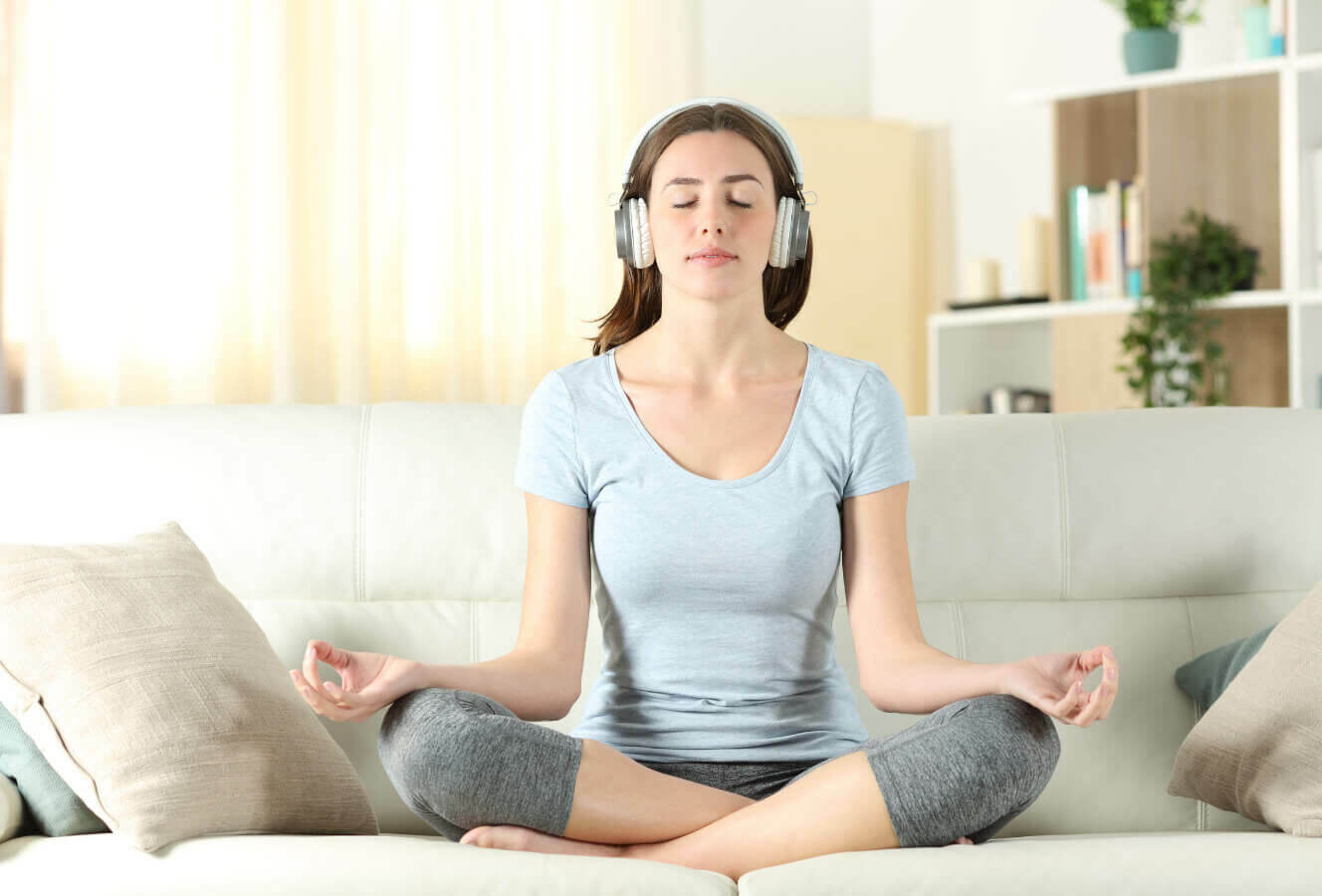
What is Guided Meditation: Benefits and Types Explored
For the bulk of my adult life, I thought that in order to meditate you had to be alone, in a quiet room and your mind had to be empty (there are plenty of other myths you can read about here). Then I discovered the free Insight Timer meditation app and guided meditation.
To say that my life changed in a big way would be a huge understatement.
What Is Guided Meditation
In case you haven’t heard of it, guided meditation is a practice in which an individual follows the instruction of another person. You may have heard it also referred to as guided imagery or creative visualization. This can be done in-person or through a recorded voice (aka Insight Timer), to help you navigate through the meditation process.
Your guide through the experience provides verbal instructions and/or prompts to assist you in focusing your mind and entering a state of relaxation. The guide (or teacher) doesn’t always talk throughout the entire meditation. There are usually periods of silence, relaxing music, or sounds sprinkled throughout the session.
This approach is particularly beneficial for beginners (that would have been me) and those who are easily distracted (also me). By having someone else to guide you, you can more easily settle into a meditative state and gradually develop your own meditation skills.
Types of Guided Meditations

There are various types of guided meditations, each with its own unique focus, technique, or purpose. Some common techniques include sessions directed towards breath, visualization, inspiration, heart-centered, body scan, loving-kindness, and mindfulness. Guided sleep meditations are also one of the most popular forms used on Insight Timer.
Each technique offers different benefits, and can help in addressing specific concerns or goals. Initially, I was searching for sessions to help me as I started my journey in recovering from a narcissistic abusive marriage. Eventually, I started creating my own sessions to better fit my needs. By exploring different types of guided meditations available, I found the best fit for my personal needs and preferences. Here are descriptions of the more common type of meditation:
Mindfulness Meditation
Mindfulness meditation focuses on training your attention to be present in the moment, observing thoughts and emotions without judgment. This practice often involves focusing on the breath or an object while letting other thoughts come and go as they please.

Breathing Meditation
A breathing exercise is essentially a mindfulness technique that involves deep, even-paced breathing using the diaphragm muscle to expand the lungs. The purpose is to slow down our breathe, take in more oxygen. You will also reduce the use of your shoulder, neck, and upper chest muscles while breathing so that you breathe more efficiently. The practice involves focusing on your breath as you inhale and exhale, and allowing thoughts to come and go without judgment or attachment.
Body Scan Meditation
A body scan meditation guides you through becoming more aware of sensations in your body, helping you relax and release tension. You’ll typically be instructed to focus on different body parts in a systematic order, from head to toe or vice versa, noticing any sensations or areas of tightness.
Loving-kindness Meditation
Loving-kindness meditation, or Metta meditation, aims to cultivate feelings of love and compassion towards oneself and others. You’ll be guided to mentally send positive thoughts and well wishes to individuals or groups, gradually expanding your circle of compassion to include all beings.
Visualization Meditation
In visualization meditation, you’re guided through the process of visualizing a peaceful and calming scene or situation. This technique helps you develop a sense of inner peace and tranquility, while also enhancing your creativity and mental focus.
Chakra Meditation
Chakra meditation focuses on aligning and balancing the body’s energy centers, known as chakras. You’ll be guided to visualize each chakra with corresponding colors and sounds, aiming to create a balanced flow of energy throughout your body and improving overall well-being.
Yoga Nidra Meditation
Yoga Nidra, also known as yogic sleep or sleep with awareness, is a guided meditation that takes you through different stages of consciousness while remaining in a state of deep relaxation. The goal is to achieve mental, emotional, and physical rest, promoting stress relief and self-awareness.
Affirmation Meditation
Affirmation, or mantra, meditation involves using positive statements that assert specific goals or desires. You’ll be guided to repeat these affirmations to yourself, helping to reprogram your thoughts and beliefs, thereby influencing your actions and behaviors in daily life.
I will also add that what you prefer and need will change over time. And that is the beautiful thing about using an app like Insight Timer; as you change, you have the ability to find other techniques and benefits that address new desires and needs.
Listen to my meditations on the free Insight Timer app OR YouTube 🧘
Benefits of Guided Meditation
The list of benefits by using guided meditation is as long as my arm. This includes benefits such as reduced symptoms of anxiety and depression, improved ability to think, concentrate and solve problems, and the development of skills to manage stress.
And there’s more! Guided meditation can help in building self-awareness, increasing imagination and creativity, and enhancing patience and tolerance. Let’s look at each of these a little more in-depth.
Reduced Stress and Anxiety
Guided meditation can effectively help in reducing stress and anxiety by calming the mind and focusing on the present moment. Practices like meditation have been shown to reverse the stress response, which helps in shielding individuals from the negative effects of chronic stress, such as decreased production of cortisol by the adrenal glands and normalization of blood pressure.
Improved Sleep
According to the National Center for Complementary and Integrative Health, practicing meditation may help reduce symptoms of insomnia, leading to better sleep quality. By quieting the mind, individuals may find it easier to fall asleep and stay asleep. I use this form of meditation every night and even in the middle of the night if I have trouble sleeping.
Enhanced Concentration
Meditation techniques involve developing intentional focus, which has been shown to improve concentration, and the ability to stay centered. As a result, this can boost cognitive abilities and enhance productivity.
Emotional Health and Well-being
Meditation promotes a sense of calm, peace, and balance, which can benefit both emotional well-being and overall health. Regular practice can help individuals better manage their emotions, leading to a more positive outlook on life and improved resilience when facing challenges.
Mind and Body Connection
As a form of mind-body medicine, meditation helps foster a stronger mind-body connection. Some benefits of this type include promoting relaxation and building awareness of the physical body. This connection is important for overall wellness and may improve physical health as well.
Self-awareness and Personal Growth
Meditation allow us to focus on ourselves, practice mindfulness and listen to our inner experience. This leads to greater self-awareness and personal growth. Through continuous practice, we can better understand our thought patterns, emotions, and reactions. We realize the benefits of meditation through self-improvement and increased quality of life.
How to Start With Guided Meditation

Choosing the Appropriate Style
Since there are so many different types of guided meditations, I recommend exploring the various styles. Take each one on a test drive and choose the one that resonates with you the most. Consider your personal preferences, goals, and experience level when making a decision. Researching guided meditations online, such as Insight Timer or Headspace, can help you identify the style that suits you the best (there are plenty out there so you have loads of choices).
Finding a Quiet Space
Once you’ve determined the style you want to practice, find a quiet and comfortable space where you can relax without distractions. Your chosen environment should allow you to focus on the meditation practice experience and be free of noisy interruptions. This could be a dedicated meditation space in your home, a quiet corner in a park, or any other location where you can feel calm and centered.
Duration and Consistency
I suggest starting with short sessions, such as 10-15 minutes, and gradually increase the duration as you become more comfortable with the practice. Set aside time to maintain consistency in your meditation routine. You can use a meditation course (also available on most of the meditation apps). The bottom line is that a regular practice will yield better results and help you cultivate a deeper understanding of the meditation process (and you’ll feel better too).
Joining a Group or Class
For beginners, joining a guided meditation group led by an experienced teacher can be especially helpful. Or go to a meditation class (I love my local meditation center). These in-person sessions will provide additional guidance, support, and the opportunity to share your experiences with others.
Listen to my meditations on the free Insight Timer app OR YouTube 🧘
Find Your Meditation
At the end of the day, guided meditation is a powerful tool for those looking to improve their mental and physical well-being. As a form of meditation, it involves a teacher or guide leading you through the practice, sharing verbal cues, meditation music, or other sensory experiences to help you focus your attention and relax your mind and body.
As we discovered, the benefits of guided meditation are numerous and range from reducing stress and anxiety to improving sleep quality, increasing self-awareness, and promoting emotional well-being. And don’t forget that we can also improve our concentration, reduce negative emotions, and boost overall mental and physical health.
Incorporating guided meditation into your daily routine can be a simple yet effective way to improve your overall well-being. Whether you’re new to meditation or a seasoned practitioner, guided meditation can be a powerful tool to help you achieve a greater sense of calm, clarity, and inner peace.




